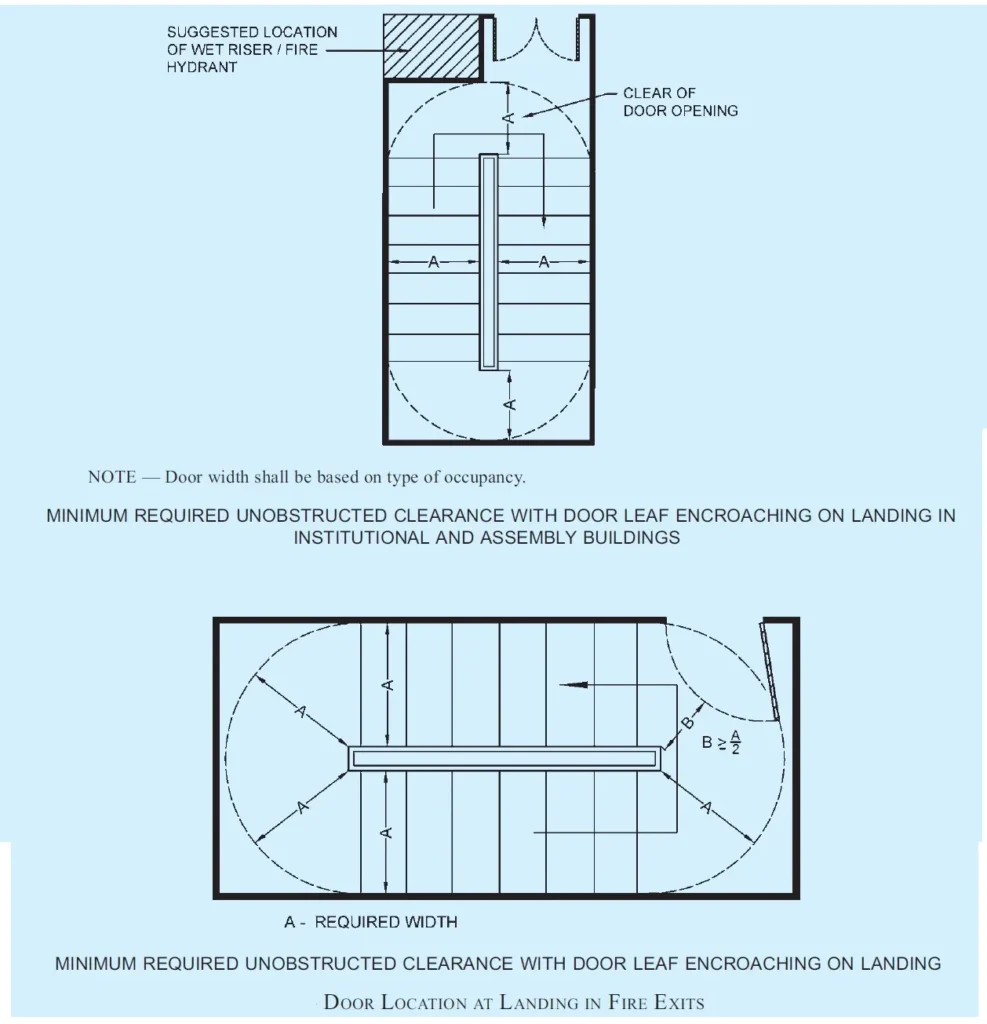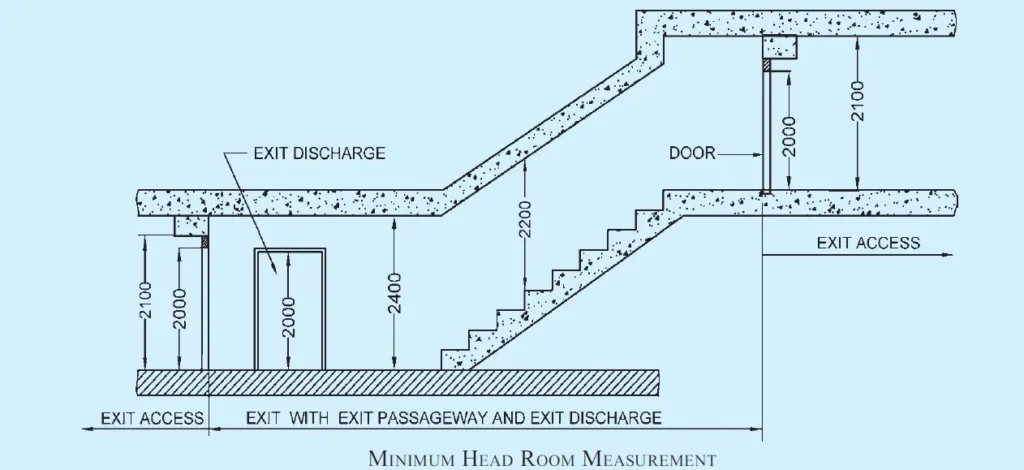If you want to know about the smoke movement in building or air distribution system or fire-fighting in multistory developments, please click the link.
General exit requirements refer to the criteria that must be met for someone to successfully leave a particular situation, program, or organization.
- An exit may be a fire exit doorway; an internal staircase, exit passageway, external doorway, external staircase and these having access to the street or to a Veranda or to a refuge area or to the terrace or roof of a building.
- An exit may also include a horizontal exit leading to an adjoining building/fire compartment having its further access to unlocked/public exit at the same level. Unless otherwise specified, lifts, escalators, moving walks and revolving doors shall not be considered as exits and shall not constitute any part of the required exit.
- Every exit, exit passageway and exit discharge shall be continuously maintained free of all obstructions or impediments to full use in the case of fire or other emergency.
- Every building having human occupancy shall be provided with exits sufficient to permit safe egress of occupants, in case of fire or other emergency.
- In every building or structure, exits shall comply with the minimum requirements of this Part, except those not accessible for general public use.
- No building shall be so altered as to reduce the number, width or protection of exits to less than that required.
- For non-naturally ventilated areas, fire doors with 120 min fire resistance rating shall be provided and particularly at the entrance to lift lobby and stair well where a funnel or flue effect. may be created, inducing an upward spread of fire, to prevent spread of fire and smoke.
- Exits shall be so arranged that they may be reached without passing through another occupied unit/passage in others control, if they pose challenge or restriction in means of egress.
- Doors in exits shall open in the direction of exit.
- In case of assembly buildings (Group D) and institutional buildings (Group C-1), exit door shall not open immediately upon a flight of stair and all such entries to the stair shall be through a landing, so that such doors do not impede movement of people descending from a higher floor when fully opened (see Figure below).

- While for other occupancies, such doors shall not reduce the pathway in the landing by more than half the width of such staircase (see Figure above). Over-head or sliding doors shall not be installed.
- At least half of the required exit stairs from upper floors (rounded to the next higher number) shall discharge directly to the exterior or through exit passageways. Unless otherwise specified, all the exits and exit passageways to exit discharge shall have a clear ceiling height of at least 2.4 m. However, the height of exit door shall be at least 2.0 m (see Figure below).

- Where changes in elevation of more than 300 mm are encountered in the exits, ramps or sloped surfaces shall be used with handrails and floor finish materials that contrast with the adjacent finish materials.
- The capacity of the means of egress required from any storey of the building shall not be reduced along the path of egress travel until arrival to the exit discharge.
- The lifts, escalators, moving walks, turnstiles and revolving doors shall not be considered in determining the required capacity of means of egress for the individual floor(s) or the building.
- Turnstiles or similar devices that restrict travel to one direction or that are used to restrict unauthorized entry shall not be so placed as to obstruct any required means of egress. Alternative door openings of required exit width shall be available within 3 m of such devices, if installed.
- Suitable means shall be provided so that all access-controlled exit doors, turnstiles, boom barriers and other such exits shall automatically operate to open mode during emergencies like fire, smoke, acts of terrorism, etc., so that people can safely and quickly egress into safe areas outside. If required, a master controlling device may be installed at a strategic location to achieve this.
- Penetrations into and openings through an exit are prohibited except those necessary likes for the fire protection piping, ducts for pressurization and similar life safety services. Such openings as well as vertical passage of shaft through floors shall be protected by passive systems.
- Walking surfaces in exit access shall comply with the following requirements for smooth exit:
- Walking surfaces shall be nominally level.
- The slope of walking surface in the direction of travel shall not exceed 1 in 20 unless the ramp requirements are met (see ramp).
- Slope perpendicular to the direction of travel shall not exceed 1 in 48.
- Walking surfaces shall be slip-resistant along the entire path of travel.
For Basement
- Basement exits shall be sufficient to provide for the capacity of the basement as determined in accordance with above points. In no case shall there be less than two independent basement exits.
- Basements having incidental occupancies to main occupancy shall be planned with exit requirements of the basements for the actual occupancy within the basement.
- Where basement is used for car parking and also there is direct approach from any occupancy above to the basement, door openings leading to the basement shall need to be protected with fire doors with 120 min fire rating, except for exit discharge doors from the basements.
Overall, the specific exit requirements will vary depending on the situation, but it is important to understand and meet these requirements to ensure a smooth transition out of the situation or organization.
I want to build mini theater